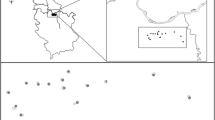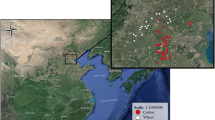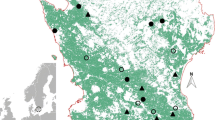Abstract
Context
The importance of landscape complexity for biological control is well-known, but its functional roles are poorly understood.
Objectives
We evaluated the landscape capacity to provide floral resources for beneficial insects and its consequences for biological control in fields.
Methods
The gut contents of adult hoverflies sampled in 41 cereal fields were analysed to determine which plant species are exploited. The relative value of each habitat in providing adequate pollen resources was evaluated by vegetation survey. Then 15 cereal fields were selected along a gradient of landscape complexity, where the abundance of aphids, hoverfly larvae and aphid parasitism was monitored. The habitat’s proportions in landscape buffers surrounding these fields were used as landscape descriptors and to assess the potential level of pollen resources provision (LP index).
Results
Aphid abundance significantly decreased with an increase of the LP index mainly sustained by grassy strips and weeds in fields. However, hoverfly larvae abundance also decreased with the increasing LP index. The enhancement of the aphid parasitism rate with the LP index suggests that aphid parasitoids may benefit from the same floral resources as hoverflies. Their crop habitat specialism may give them a competitive advantage in fields where both aphid and floral resources are abundant.
Conclusions
Complex interaction networks involved in biological control may disrupt the expected direct effects of floral resource provisioning for a focal beneficial species. We highlighted fields and grassy strips as habitats provisioning floral resources for which the LP index could be very helpful to optimize agroecological management strategies.




Similar content being viewed by others
References
Al Hassan D, Georgelin E, Delattre T, Burel F, Plantegenest M, Kindlmann P, Butet A (2013) Does the presence of grassy strips and landscape grain affect the spatial distribution of aphids and their carabid predators? Agric For Entomol 15:24–33
Alignier A, Raymond L, Deconchat M, Menozzi P, Monteil C, Sarthou JP, Vialatte A, Ouin A (2014) Landscape influence on the abundance of aphids, mummies and aphidophagous hoverflies in winter wheat fields varies over the time. Biol Control 77:76–82
Almohamad R, Verheggen FJ, Francis F, Hance T, Haubruge E (2008) Discrimination of parasitized aphids by a hoverfly predator: effect on larval performance, foraging and oviposition behavior. Entomol Exp Appl 128:73–80
Altieri MA, Whitcomb WH (1979) The potential use of weeds in the manipulation of beneficial insects. HortScience 14:12–18
Arrignon F, Deconchat M, Sarthou JP, Balent G, Monteil C (2007) Modelling the overwintering strategy of a beneficial insect in a heterogeneous landscape using a multi-agent system. Ecol Model 205:423–436
Aupinel P, Genissel A, Tasei JN, Poncet J, Gomond S (2001) Collection of spring pollens by Bombus terrestris queens. Assessment of attractiveness and nutritive value of pollen diets. Acta Horticult 561:101–105
Bianchi FJ, Booij CJH, Tscharntke T (2006) Sustainable pest regulation in agricultural landscapes: a review on landscape composition, biodiversity and natural pest control. Proc R Soc Biol Sci Ser B 273:1715–1727
Bianchi FJ, Schellhorn NA, Cunningham SA (2013) Habitat functionality for the ecosystem service of pest control: reproduction and feeding sites of pests and natural enemies. Agric For Entomol 15:12–23
Brewer MJ, Elliott NC (2004) Biological control of cereal aphids in North America and mediating effects of host plant and habitat manipulations. Annu Rev Entomol 49:219–242
Broström A, Nielsen AB, Gaillard MJ, Hjelle K, Mazier F, Binneey H, Bunting J, Fyfe R, Meltsov V, Poska A (2008) Pollen productivity estimates of key European plant taxa for quantitative reconstruction of past vegetation: a review. Veg Hist Archaeobot 17:461–478
Burnham KP, Anderson DR (2002) Model selection and multimodel inference: a practical information-theoretic approach. Springer, Berlin
Chambers RJ (1988) Syrphidae. In: Minks AK, Harrewijn P (eds) World crop pests: aphids, their biology. Natural Enemies and Control Elsevier, Amsterdam
Chaplin-Kramer R, O’Rourke ME, Blitzer EJ, Kremen C (2011) A meta-analysis of crop pest and natural enemy response to landscape complexity. Ecol Lett 14:922–932
Cowgill SE, Wratten SD, Sotherton NW (1993) The selective use of floral resources by the hoverfly Episyrphus balteatus (Diptera: Syrphidae) on farmland. Ann Appl Biol 122:223–231
Derocles SA, Le Ralec A, Besson MM, Maret M, Walton A, Evans DM, Plantegenest M (2014) Molecular analysis reveals high compartmentalization in aphid-primary parasitoid networks and low parasitoid sharing between crop and noncrop habitats. Mol Ecol 23:3900–3911
Duflot R, Aviron S, Ernoult A, Fahrig L, Burel F (2015) Reconsidering the role of ‘semi-natural habitat’ in agricultural landscape biodiversity: a case study. Ecol Res 30:75–83
Dunning JB, Danielson BJ, Pulli HR (1992) Ecological processes that affect populations in complex landscapes. Oikos 65:169–175
Ernoult A, Vialatte A, Butet A, Michel N, Rantier Y, Jambon O, Burel F (2013) Grassy strips in their landscape context, their role as new habitat for biodiversity. Agric Ecosyst Environ 166:15–27
Fahrig L, Baudry J, Brotons L, Burel F, Crist TO, Fuller RJ, Sirami C, Siriwardena GM, Martin JL (2011) Functional landscape heterogeneity and animal biodiversity in agricultural landscapes. Ecol Lett 14:101–112
Fontaine C, Dajoz I, Meriguet J, Loreau M (2006) Functional diversity of plant–pollinator interaction webs enhances the persistence of plant communities. PLoS Biol 4:129–135
Forman RTT, Godron M (1986) Landscape ecology. Wiley, New York, p 619
Garibaldi LA, Steffan-Dewenter I, Kremen C, Morales JM, Bommarco R, Cunningham SA (2011) Stability of pollination services decreases with isolation from natural areas despite honey bee visits. Ecol Lett 14:1062–1072
Gillespie M, Wratten S, Sedcole R, Colfer R (2011) Manipulating floral resources dispersion for hoverflies (Diptera: Syrphidae) in a California lettuce agro-ecosystem. Biol Control 59:215–220
Heimpel GE, Jervis MA (2005) Does floral nectar improve biological control by parasitoids? In: Wäckers F, vanRijn P, Bruin J (eds) Plant-provided food for carnivorous insects: a protective mutualism and its applications. Cambridge University Press, Cambridge, pp 267–304
Hickman JM, Wratten SD (1996) Use of Phacelia tanacetifolia strips to enhance biological control of aphids by hoverfly larvae in cereal fields. J Econ Entomol 89:832–840
Hickman JM, Lovei GL, Wratten SD (1995) Pollen feeding by adults of the hover fly Melanostoma fasciatum (Diptera: Syrphidae). N Z J Zool 22:387–392
Hogg BN, Bugg RL, Daane KM (2011) Attractiveness of common insectary and harvestable floral resources to beneficial insects. Biol Control 56:76–84
Holzschuh A, Dudenhoffer JH, Tscharntke T (2012) Landscapes with wild bee habitats enhance pollination, fruit set and yield of sweet cherry. Biol Conserv 153:101–107
Hyde HA, Adams KF (1958) An atlas of airborne pollen grains. Macmillan, London, p 112
Jacobs J (1974) Quantitative measurement of food selection: a modification of the forage ratio and Ivlev’s electivity index. Oecologia 14:413–417
Jauker F, Diekötter T, Schwarzbach F, Wolters V (2009) Pollinator dispersal in an agricultural matrix: opposing responses of wild bees and hoverflies to landscape structure and distance from main habitat. Landscape Ecol 24:547–555
Jauker F, Wolters V (2008) Hoverflies are efficient pollinators of oilseedrape. Oecologia 156:819–823
Jonsson M, Straub CS, Didham RK, Buckley HL, Case BS, Hale RJ, Gratton C, Wratten SD (2015) Experimental evidence that the effectiveness of conservation biological control depends on landscape complexity. J Appl Ecol 52:1274–1282
Kattge J, Diaz S, Lavorel S, Prentice IC, Leadley P, Bönisch G, Garnier E, Westoby M, Reich PB, Wright IJ, Cornelissen JHC, Violle C, Harrison SP, Van Bodegom PM, Reichstein M, Enquist BJ, Soudzilovskaia NA, Ackerly DD, Anand M, Atkin O, Bahn M, Baker TR, Baldocchi D, Bekker R, Blanco CC, Blonder B, Bond WJ, Bradstock R, Bunker DE, Casanoves F, Cavender-Bares J, Chambers JQ, Chapin Iii FS, Chave J, Coomes D, Cornwell WK, Craine JM, Dobrin BH, Duarte L, Durka W, Elser J, Esser G, Estiarte M, Fagan WF, Fang J, Fernández-Méndez F, Fidelis A, Finegan B, Flores O, Ford H, Frank D, Freschet GT, Fyllas NM, Gallagher RV, Green WA, Gutierrez AG, Hickler T, Higgins SI, Hodgson JG, Jalili A, Jansen S, Joly CA, Kerkhoff AJ, Kirkup D, Kitajima K, Kleyer M, Klotz S, Knops JMH, Kramer K, Kühn I, Kurokawa H, Laughlin D, Lee TD, Leishman M, Lens F, Lenz T, Lewis SL, Lloyd J, Llusià J, Louault F, Ma S, Mahecha MD, Manning P, Massad T, Medlyn BE, Messier J, Moles AT, Müller SC, Nadrowski K, Naeem S, Niinemets Ü, Nöllert S, Nueske A, Ogaya R, Oleksyn J, Onipchenko VG, Onoda Y, Ordonez J, Overbeck G, Ozinga WA, Patiño S, Paula S, Pausas JG, Peñuelas J, Phillips OL, Pillar V, Poorter H, Poorter L, Poschlod P, Prinzing A, Proulx R, Rammig A, Reinsch S, Reu B, Sack L, Salgado-Negret B, Sardans J, Shiodera S, Shipley B, Siefert A, Sosinski E, Soussana J-F, Swaine E, Swenson N, Thompson K, Thornton P, Waldram M, Weiher E, White M, White S, Wright SJ, Yguel B, Zaehle S, Zanne AE, Wirth C (2011) TRY—a global database of plant traits. Glob Change Biol 17:2905–2935
Klein AM, Vaissiere BE, Cane JH, Steffan-Dewenter I, Cunningham SA, Kremen C, Tscharntke T (2007) Importance of pollinators in changing landscapes for world crops. Proc R Soc Biol Sci Ser B 274:303–313
Kleyer M, Bekker RM, Knevel IC, Bakker JP, Thompson K, Sonnenschein M, Poschlod P, Van Groenendael JM, Klimeš L, Klimešová J, Klotz SRGM, Rusch GM, Hermy M, Adriaens D, Boedeltje D, Bossuyt B, Dannemann A, Endels P, Götzenberger L, Hodgson JG, Jackel AK, Kühn I, Kunzmann D, Ozinga WA, Römermann C, Stadler M, Schlegelmilch J, Steendam HJ, Tackenberg O, Wilmann B, Cornelissen JHC, Eriksson O, Garnier E, Peco B (2008) The LEDA Traitbase: a database of life-history traits of the Northwest European flora. J Ecol 96:1266–1274
Kremen C, Williams NM, Bugg RL, Fay JP, Thorp RW (2004) The area requirements of an ecosystem service: crop pollination by native bee communities in California. Ecol Lett 7:1109–1119
Landis DA, Wratten SD, Gurr GM (2000) Habitat management to conserve natural enemies of arthropod pests in agriculture. Annu Rev Entomol 45:175–201
Meyer B, Jauker F, Steffan-Dewenter I (2009) Contrasting resource-dependent responses of hoverfly richness and density to landscape structure. Basic Appl Ecol 10:178–186
Ockinger E, Smith HG (2007) Semi-natural grasslands as population sources for pollinating insects in agricultural landscapes. J Appl Ecol 44:50–59
Parry H, Macfadyen S, Hopkinson JE, Bianchi FJJA, Zalucki MP, Bourne A, Schellhorn NA (2015) Plant composition modulates arthropod pest and predator abundance: evidence for culling exotics and planting natives. Basic Appl Ecol 16:531–543
Patt JM, Hamilton GC, Lashomb JH (1997) Impact of strip-insectary intercropping with flowers on conservation biological control of the Colorado potato beetle. Adv Hortic Sci 11:175–181
Power EF, Stout JC (2011) Organic dairy farming: impacts on insect-flower interaction networks and pollination. J Appl Ecol 48:561–569
R Development Core Team (2015) R: a language and environment for statistical computing. R Foundation for Statistical Computing, Vienna. http://www.R-project.org/
Rader R, Edwards W, Westcott DA, Cunningham SA, Howlett BG (2011) Pollen transport differs among bees and flies in a human-modified landscape. Divers Distrib 17:519–529
Raymond L, Plantegenest M, Gauffre B, Sarthou JP, Vialatte A (2014) Immature hoverflies overwinter in cultivated fields and may significantly control aphid populations in autumn. Agric Ecosyst Environ 185:99–105
Rebek EJ, Sadof CS, Hanks LM (2005) Manipulating the abundance of natural enemies in ornamental landscapes with floral resource plants. Biol Control 33:203–216
Rivero A, Casas J (1999) Incorporating physiology into parasitoid behavioral ecology: the allocation of nutritional resources. Res Popul Ecol 41:39–45
Root RB (1973) Organization of a plant-arthropod association in simple and diverse habitats: the fauna of collards (Brassica oleracea). Ecol Monogr 43:95–124
Rusch A, Valantin-Morison M, Roger-Estrade J, Sarthou JP (2012) Local and landscape determinants of pollen beetle abundance in overwintering habitats. Agric For Entomol 14:37–47
Schellhorn N, Gagic V, Bommarco R (2015) Time will tell: resource continuity bolster ecosystem services. Trends Ecol Evol 30:524–530
Schmidt MH, Lauer A, Purtauf T, Thies C, Schaefer M, Tscharntke T (2003) Relative importance of predators and parasitoids for cereal aphid control. Proc R Soc London B 270:1905–1909
Sørensen T (1948) A method of establishing groups of equal amplitude in plant sociology based on similarity of species and its application to analyses of the vegetation on Danish commons. Biologiske Skrifter/Kongelige Danske Videnskabernes Selskab 5:1–34
Steffan-Dewenter I, Münzenberg U, Bürger C, Thies C, Tscharntke T (2002) Scale-dependent effects of landscape structure on three pollinator guilds. Ecology 83:1421–1432
Tena A, Pekas A, Cano D, Wackers FL, Urbaneja A (2015) Sugar provisioning maximizes the biocontrol service of parasitoids. J Appl Ecol 52:795–804
Tenhumberg B, Poehling HM (1995) Syrphids as natural enemies of cereal aphids in Germany: aspects of their biology and efficacy in different years and regions. Agric Ecosyst Environ 52:39–43
Tenhumberg B, Siekmann G, Keller MA (2006) Optimal time allocation in parasitic wasps searching for hosts and food. Oikos 113:121–131
Tscharntke T, Karp DS, Chaplin-Kramer R, Batary P, DeClerck F, Gratton C, Hunt L, Ives A, Jonsson M, Larsen A, Martin EA, Martinez-Salinas A, Meehan TD, O’Rourke M, Poveda K, Rosenheim JA, Rusch A, Schellhorn N, Wanger TC, Wratten S, Zhang W (2016) When natural habitat fails to enhance biological control—five hypotheses. Biol Conserv 204:449–458
Tscharntke T, Klein AM, Kruess A, Steffan-Dewenter I, Thies C (2005) Landscape perspectives on agricultural intensification and biodiversity: ecosystem service management. Ecol Lett 8:857–874
Tylianakis JM, Didham RK, Wratten SD (2004) Improved fitness of aphid parasitoids receiving resource subsidies. Ecology 85:658–666
Van Rijn PCJ, Wäckers FL (2016) Nectar accessibility determines fitness, flower choice and abundance of hoverflies that provide natural pest control. J Appl Ecol 53:925–933
Van Veen MP (2004) Hoverflies of Northwest Europe, identification keys to the Syrphidae. KNNV publishing, Utrecht, p 254
Villenave-Chasset J, Deutsch B, Lodé T, Rat-Morris E (2006) Pollen choice by the Chrysoperla species (Neuroptera: Chrysopidae) occurring in the crop environment of western France. Eur J Entomol 103:771–777
White AJ, Wratten SD, Berry NA, Weigmann U (1995) Habitat manipulation to enhance biological control of Brassica pests by hoverflies (Diptera: Syrphidae). J Econ Entomol 88:1171–1176
Wratten SD, Bowie MH, Hickman JM, Evans AM, Sedcole JR, Tylianakis JM (2003) Field boundaries as barriers to movement of hoverflies (Diptera: Syrphidae) in cultivated land. Oecologia 134:605–611
Wroblewska A, Stawiarz E (2012) Flowering of two Arctium L. species and their significance as a source of pollen for visiting insects. J Apic Res 51:78–84
Acknowledgements
The Authors would like to thank Eric Petit for his advice on statistical analyses, Andrew Hamilton for revising the English in the manuscript, and Tony Couanon, Julia Saulais, Ludmilla Martin and the local Landscaphid staff for their help in insect sampling. The study was supported by funding from « Programmes Interdisciplinaires du CNRS 2008 » for the project named ParaBEn and the ANR Systerra program (French National Research agency, ANR-09-STRA-05).
Author information
Authors and Affiliations
Corresponding author
Electronic supplementary material
Below is the link to the electronic supplementary material.
Rights and permissions
About this article
Cite this article
Vialatte, A., Tsafack, N., Hassan, D.A. et al. Landscape potential for pollen provisioning for beneficial insects favours biological control in crop fields. Landscape Ecol 32, 465–480 (2017). https://doi.org/10.1007/s10980-016-0481-8
Received:
Accepted:
Published:
Issue Date:
DOI: https://doi.org/10.1007/s10980-016-0481-8




